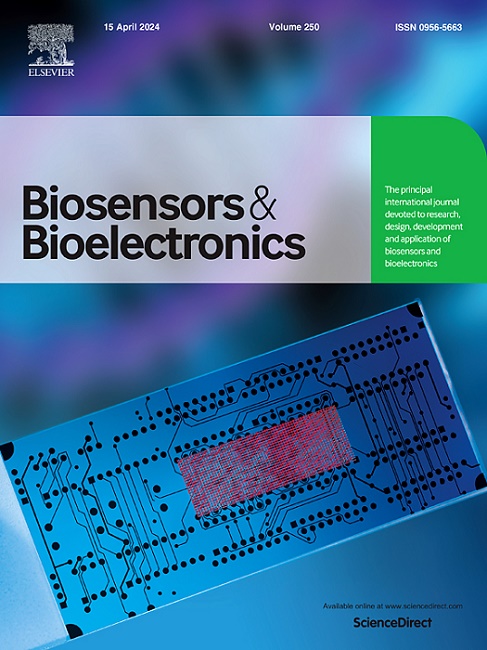Novel lateral flow assay to detect H2O2 by utilizing self-biotinylation of G-quadruplex
IF 10.7
1区 生物学
Q1 BIOPHYSICS
引用次数: 0
Abstract
We herein describe a novel lateral flow assay (LFA) to detect H2O2 by utilizing self-biotinylation of G-quadruplex (G4). In this strategy, the G4 strand promotes the self-biotinylation of G4 itself in the presence of H2O2, which is then allowed to bind to the FAM-labeled complementary detector probe. The resulting biotin-labeled G4/FAM-detector probe complex is captured on the test line, producing a red-colored band during lateral flow readout. Based on this unique approach, we achieved the naked-eye detection of target H2O2 at concentrations as low as 1 μM, with reliable quantification down to 0.388 μM. This method also demonstrated exceptional specificity in distinguishing H2O2 from other non-target molecules. We further verified its versatile applicability by reliably identifying another biomolecule, choline, by coupling with choline oxidase, which generates H₂O₂ during oxidation. This novel LFA strategy holds great promise as a powerful point-of-care testing (POCT) platform for detecting a large spectrum of target biomolecules by employing their corresponding oxidases.
利用 G-quadruplex 的自生物素化作用检测 H2O2 的新型横向流动分析法。
我们在此介绍一种新型横向流动检测法(LFA),利用 G-四重链(G4)的自生物素化来检测 H2O2。在这一策略中,G4 链在 H2O2 的存在下促进 G4 自身的生物素化,然后让 G4 与 FAM 标记的互补检测探针结合。由此产生的生物素标记的 G4/FAM 检测器探针复合物被检测线捕获,在横向流动读数过程中产生红色条带。基于这种独特的方法,我们实现了目标 H2O2 的肉眼检测,检测浓度低至 1 μM,可靠定量低至 0.388 μM。这种方法在区分 H2O2 和其他非目标分子方面也表现出了极高的特异性。我们通过与胆碱氧化酶(它在氧化过程中会产生 H₂O₂)联用,可靠地鉴定了另一种生物大分子胆碱,从而进一步验证了该方法的广泛适用性。这种新颖的 LFA 策略有望成为一种功能强大的床旁检测(POCT)平台,通过使用相应的氧化酶来检测大量目标生物大分子。
本文章由计算机程序翻译,如有差异,请以英文原文为准。
求助全文
约1分钟内获得全文
求助全文
来源期刊

Biosensors and Bioelectronics
工程技术-电化学
CiteScore
20.80
自引率
7.10%
发文量
1006
审稿时长
29 days
期刊介绍:
Biosensors & Bioelectronics, along with its open access companion journal Biosensors & Bioelectronics: X, is the leading international publication in the field of biosensors and bioelectronics. It covers research, design, development, and application of biosensors, which are analytical devices incorporating biological materials with physicochemical transducers. These devices, including sensors, DNA chips, electronic noses, and lab-on-a-chip, produce digital signals proportional to specific analytes. Examples include immunosensors and enzyme-based biosensors, applied in various fields such as medicine, environmental monitoring, and food industry. The journal also focuses on molecular and supramolecular structures for enhancing device performance.
 求助内容:
求助内容: 应助结果提醒方式:
应助结果提醒方式:


